Garden Design
Time spent in preparation can be worth ten times the investment later on when you decide that a particular tree, border etc. is not appropriate or is in the wrong place.
 Step
1 - Draw up a plan of your garden to scale on a large
piece of paper.
Step
1 - Draw up a plan of your garden to scale on a large
piece of paper.
Step 2 - Mark on this plan the things you can't change. Position of your house, windows, doors, garage, fences and other boundaries, neighbours trees/hedges, neighbours windows that overlook your garden. Don't underestimate the influence on your garden of things just outside it.
Step 3 - Make a list of the things that you need in your garden and a (realistic) wish list too.
Step 4 - Take your basic plan and your wish-list outside and start thinking about where things are going to be. Re-write your plan. If you have large windows or patio doors overlooking the garden, you could draw in the position of features using a china graph pencil on the glass to get an idea of the view. I always then leave it all alone for at least a few days before coming back to it, repeat until you're happy with the result.
As time goes on you may decide to have a rose bed or house your National collection of Euphorbias in a particular place rather than the original idea of a herbaceous border. You may go for a patio instead of decking, but at least you will have a good idea of the kinds of things in each area. Think in terms of the use of the surface, of how you will move around the garden and of vertical height.
Lay things out outside
Mark out borders, hard surfaces, lawns etc. use pegs and string, a hose pipe or even flour (washes away in time). Above all make sure the size of the features are realistic and useful. What may look a delightful shape for a deck on paper, may in reality not have any area that is actually large enough to be practical. It is better to have a worthwhile sized if mundane rectangular patio than a lovely sinuous shape where however you arrange things, there's always one table leg on the lawn.
Remember, you can make shade but you can't make sun.
Don't put the patio or other seating/eating area too far from the house or you'll be forever going back and forth for that thing you've forgotten for the 6th time.
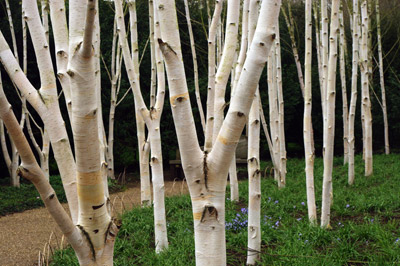
Architectural Plants
A frequently used term. If your garden is your outdoor room, then architectural plants are the furniture. They are the long-lived permanent residents that give the garden much of its shape and character. The shorter lived annuals, bulbs and herbaceous perennials are the ornaments and pictures.
When deciding on your planting, begin with architectural plants.
Design Tips
![]() Priorities. Get the patio or decking down as
soon as you can so you get the most use from them, they will
also need some fairly considerable disruption so best get it
over and minimize the impact on the garden. Get the large architectural
plants in first so they give structure as soon as possible and
can start growing towards maturity.
Priorities. Get the patio or decking down as
soon as you can so you get the most use from them, they will
also need some fairly considerable disruption so best get it
over and minimize the impact on the garden. Get the large architectural
plants in first so they give structure as soon as possible and
can start growing towards maturity.
![]() Take your time planning - don't rush it. Make
plans then ignore them for a while, come back again later and
see if you still like them. Get the overall large scale plan
sorted first with shapes of lawn, hard landscaping etc. Try
not to get sidetracked into the details too early.
Take your time planning - don't rush it. Make
plans then ignore them for a while, come back again later and
see if you still like them. Get the overall large scale plan
sorted first with shapes of lawn, hard landscaping etc. Try
not to get sidetracked into the details too early.
![]() What do you need to access through the winter?
washing line, bird feeders? try to avoid trekking across the
lawn to get there.
What do you need to access through the winter?
washing line, bird feeders? try to avoid trekking across the
lawn to get there.
![]() Place bird feeders / table / bath where they can easily
be seen from frequently used windows. You'll also get
more value from water features if they're placed
where they can be easily seen from a window.
Place bird feeders / table / bath where they can easily
be seen from frequently used windows. You'll also get
more value from water features if they're placed
where they can be easily seen from a window.
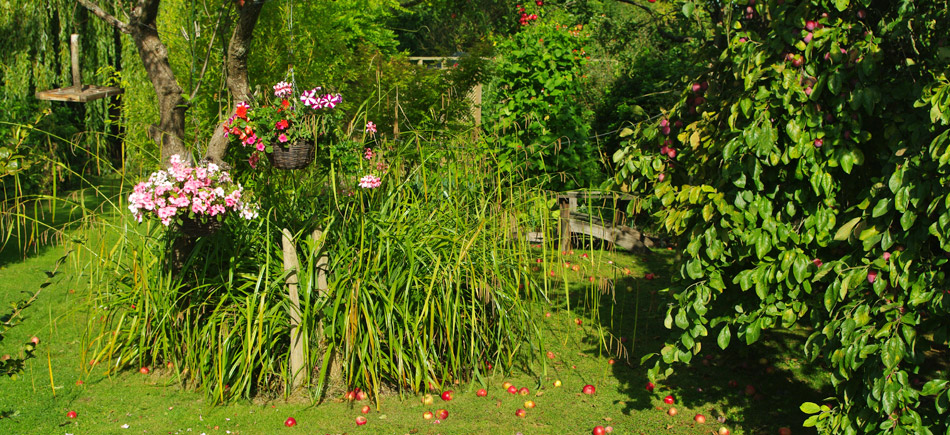
![]() Privacy in the garden is one of the most important elements.
Most people take steps to prevent passers by from seeing straight
into their living rooms and you'll feel much more comfortable
in the garden if there's no sense of being watched. The old
adage "good fences make good neighbours" definitely applies
here.
Privacy in the garden is one of the most important elements.
Most people take steps to prevent passers by from seeing straight
into their living rooms and you'll feel much more comfortable
in the garden if there's no sense of being watched. The old
adage "good fences make good neighbours" definitely applies
here.
![]() If you actively enjoy gardening have an area where you
can grow things every year, we replaced our veg plot
with a flower plot when we got an allotment and my wife loves
planning and growing each years annual summer flower display.
If you actively enjoy gardening have an area where you
can grow things every year, we replaced our veg plot
with a flower plot when we got an allotment and my wife loves
planning and growing each years annual summer flower display.
![]() Link the garden to its surroundings if possible.
If you are lucky enough to have a view of countryside or woodland.
Place sympathetic plants leading to the view to give the impression
that it is a continuation of your garden. The Japanese call
this idea the "borrowed landscape". If the view is reasonable,
but not wonderful, then a filigree screen of deciduous planting
gives a similar impression.
Link the garden to its surroundings if possible.
If you are lucky enough to have a view of countryside or woodland.
Place sympathetic plants leading to the view to give the impression
that it is a continuation of your garden. The Japanese call
this idea the "borrowed landscape". If the view is reasonable,
but not wonderful, then a filigree screen of deciduous planting
gives a similar impression.
![]() A sense of mystery and discovery is one of the most
enchanting elements of a garden;
A sense of mystery and discovery is one of the most
enchanting elements of a garden;
If possible plan the garden so that you don't see the whole from the house. There should be some parts out of immediate view, with something such as a winding path or stepping stones drawing the eye further and encouraging you to go further.
Features such as statues and pots, sculptures etc. can be successfully be placed out of immediate sight giving a sense of discovery when happened upon.
![]() Make borders as wide as you can. 2ft minimum
for small plants, up to 6ft is better if you have the space.
Rather than have a border all around the garden which will probably
be narrow by necessity, restrict the range of it but increase
the depth. Avoid straight edges, sweeping curves look
more natural and interesting. When planting beds and borders,
plant according to the ultimate height of the plants, tallest
at the back of course.
Make borders as wide as you can. 2ft minimum
for small plants, up to 6ft is better if you have the space.
Rather than have a border all around the garden which will probably
be narrow by necessity, restrict the range of it but increase
the depth. Avoid straight edges, sweeping curves look
more natural and interesting. When planting beds and borders,
plant according to the ultimate height of the plants, tallest
at the back of course.
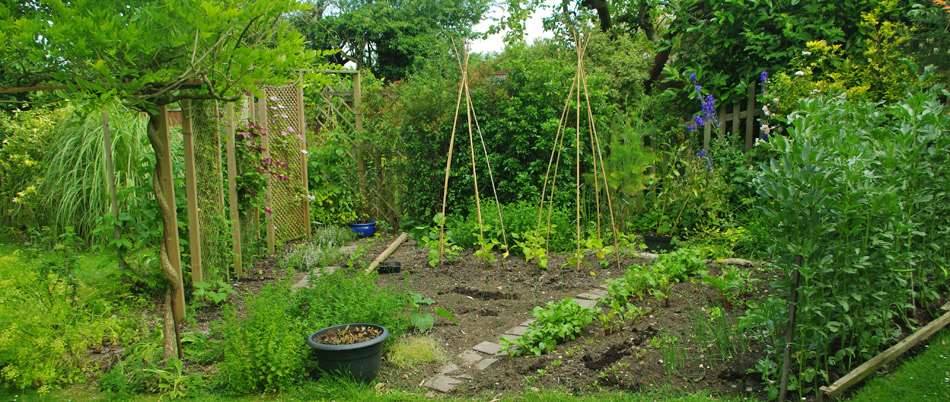
![]() Plan your planting in advance, discipline yourself not to be
side-tracked by plants that wink at you in the garden centre
and then don't really fit in, another reason I prefer
shopping online.
Plan your planting in advance, discipline yourself not to be
side-tracked by plants that wink at you in the garden centre
and then don't really fit in, another reason I prefer
shopping online.
Don't plant too many evergreens, and try to make sure that some of the ones you do plant flower and / or have berries. Non-flowering evergreens might seem an ideal answer to providing year-round interest but you could end up having a garden that hardly changes with the seasons.
Some plants are spectacular for short periods and ordinary the rest of the time. Think about what you plant near them so that they really shine when it's their turn, but have other plants around them that take turns to do their thing at a different time of the year.
![]() What should be in a garden? We're told these
days that all sorts of things belong there and weird and wonderful
materials too. Stainless steel, rusty iron, crushed glass in
various colours, steel coated in red primer, concrete looking
like concrete and even tarmac in various colours. What will
still look good in 20 years time? Alternate patio slabs in rose
and yellow shades, a deck of railway sleepers with a frame-work
of red painted steel girders or "boring" old fashioned stone
paving? (real or faux) I know where I'd put my money.
What should be in a garden? We're told these
days that all sorts of things belong there and weird and wonderful
materials too. Stainless steel, rusty iron, crushed glass in
various colours, steel coated in red primer, concrete looking
like concrete and even tarmac in various colours. What will
still look good in 20 years time? Alternate patio slabs in rose
and yellow shades, a deck of railway sleepers with a frame-work
of red painted steel girders or "boring" old fashioned stone
paving? (real or faux) I know where I'd put my money.
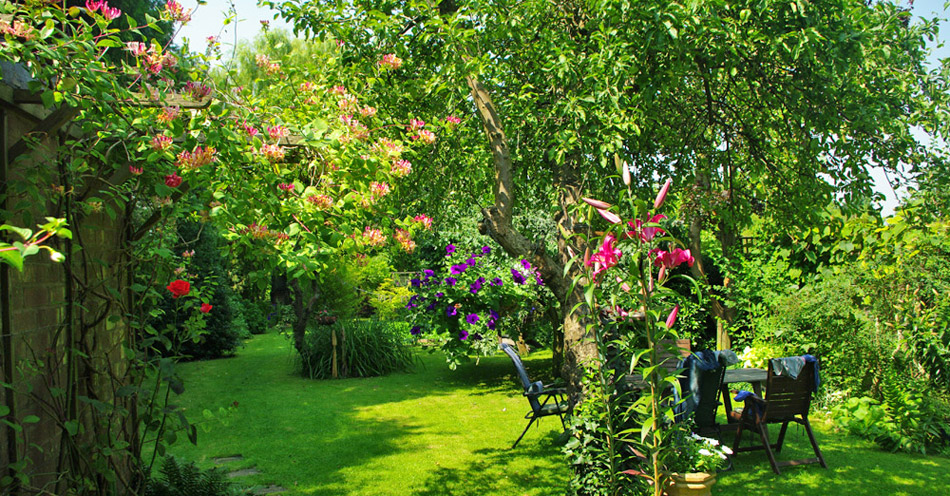
Mathematical Gardening
The Fibonacci series of numbers is a natural series discovered by the mathematician whose name is attached to them. You start with 0 and 1, then add them together to get the next number and keep adding the last two to get the next one, 0 + 1 = 1, 1 + 1 = 2, 1 + 2 = 3, 2 + 3 = 5. So the series goes 0, 1, 2, 3, 5, 8, 13, 21, etc. It turns out that all kinds of things in nature are arranged according to this series, the number of whorls of leaves around stems, the number of whorls of seeds in a sunflower head and all kinds of unlikely things that jump from one of these numbers to the next missing all of the ones in between. If you're having problems achieving a natural look in your garden, try arranging your plantings according to Fibonacci numbers, it's what mother nature does.
Alternatively if you are more classically inclined, there is the idea of the "Golden Section" from the Greeks. The ratio of 5 to 8 was thought to be the most pleasing to the eye and was used in all kinds of ways. So when designing your patio, new flower bed, where to bisect your garden when straight down the middle doesn't look so good, then do what Aristotle and Archimedes did, apply the Golden Section and proportion them in the ratio 5:8. 5 and 8 even turn out to be Fibonacci numbers too - spooky.
Low Maintenance Tips
-
Do without a lawn Grass is the most economical ground cover so this will not be a cheap option. Alternatively, reduce the grass area as much as you can and consider other surfaces.
-
Keep the shape of the lawn as simple as possible with sweeping curves and minimal planting of trees / flower beds in the lawn to speed mowing.
-
Lay a "mowing strip" all around the lawn against beds / buildings etc. This is a strip of bricks or narrow paving at the same level as the grass so that when you mow, the mower gives a good edge without having to strim. Again, not a cheap option as the edge needs to be firmly footed to stop grass and weeds growing between the bricks, once it's down though there should be no more maintenance.
-
Plant beds with ground-cover shrubs to reduce weeding.
-
Plant fairly slow-growing plants so you don't need to cut back so often. These can be interplanted with short-lived faster growing biennials and perennials if looks a bit bare to start with (though this is getting away from the low maintenance ideal).
-
Use bark chips or other mulch to minimize weeding
-
Avoid bedding plants and perennials that die back in the winter.
-
Avoid containers. These will always be more effort than planting into the ground. Because containers need to be densely planted to look good they need an awful lot of watering. Missing a few days during a hot spell in mid-summer can decimate the contents.
-
If you plant roses, then use shrub or species types, these are more resistant to disease, don't require constant dead-heading and are lower maintenance all round. Avoid "hybrid tea" roses.
-
Before you plant anything, clear perennial weeds, Dig them out or apply a weed killer. Things will be easier in the long run.
-
Soil preparation, loads of organic matter to start with, plants will get away and establish quicker meaning less looking after sooner.
-
Increase the number of drought-resistant plants in your garden e.g. Trees: Arbutus unedo (strawberry tree), hollies, Cordyline australis, pines, Robinia pseudoacacia; Shrubs; Artemesia, Cytisus (broom), Escallonia, Euphorbia characias, Hebes, Perovskia, Rosemary; perennials; Achillea, Echinacea purpureum, Eryngium, Gazania, Nepeta, Lavender.
-
If you want a lawn get a robot lawnmower - you can just sit back and watch it or tell it do do its job when you're out.
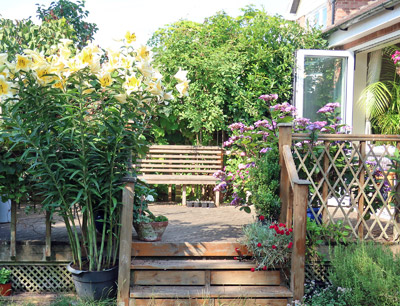
If you do use containers, maintenance can be reduced;
-
Use the largest ones that you can afford, they dry out more slowly, glazed clay or other non-porous materials will retain water better too, terra-cotta will dry out from the pot as well as the plant.
-
Place them away from windy areas if you can, wind dries plants out much more quickly than sunshine.
-
Fill with drought tolerant plants as far as possible
-
Avoid conifers, these are particularly susceptible to drying out. If they do dry out, they don't give any warning by wilting, they just look exactly the same but slowly turn brown. By the time they show they're in trouble, it's too late, and there's usually no going back.
-
Consider installing an automatic watering system.
Copyright 2000 - present. All Rights Reserved | Privacy Policy Statement




